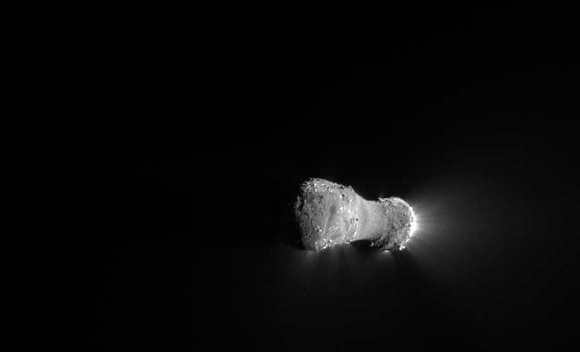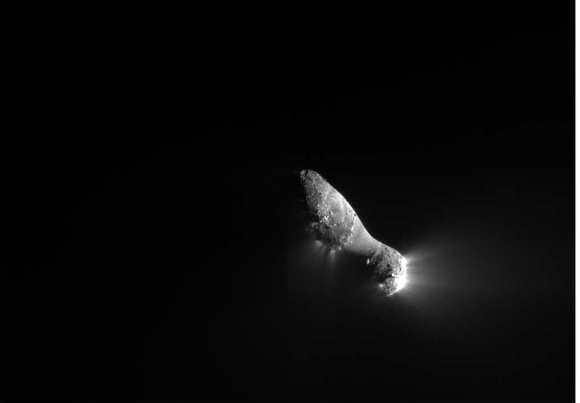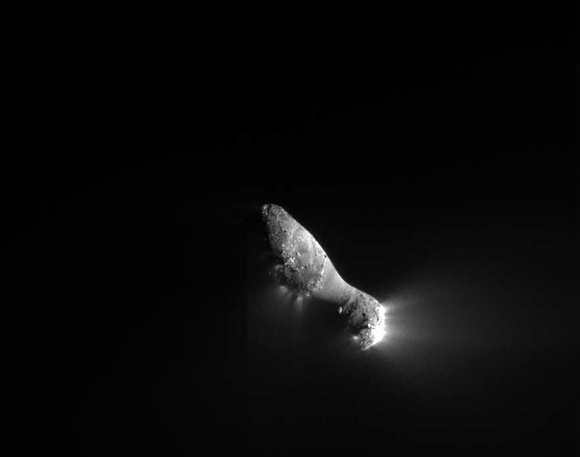[/caption]
NASA’s Deep Impact spacecraft came within 700 kilometers (435 miles) of Comet Hartley 2 at 10:01 a.m. EDT (1401 GMT) today, imaging with several cameras. Here are the first pictures released of the closest approach.
The scientific team watched along with viewers online and on NASA TV as the images were returned to Earth, about an hour after the spacecraft made its closest approach. First impressions? It is a peanut with jets.
“This is a type of moment that scientists live for,” said JPL’s Don Yeomans, “to get new results in such a dramatic fashion. The images are clear, taken as spacecraft was approaching, then as it swung past and moved away.”
The Sun is off to right, and visible is the icy surface of the comet throwing dust and gas towards the Sun.

More images will be coming down from the spacecraft and Yeomans said the scientists will be examining Hartley 2, looking for the origination spots of the jets. “Are the jets coming from the surface, or is it coming from well beneath where heat of Sun reaches into the comet? We’ll be looking for how many jets, or if possibly the whole comet outgassing. There is a single obvious jet coming off towards the Sun, but also you can see one at the 7 o’clock position, which was evident in previous images, too.”

The spacecraft uses several high-resolution instruments, and one camera can image the entire comet with a resolution of about seven meters (about 23 feet) per pixel. The spacecraft also acquired 199 medium-resolution images.
From previous images taken by EPOXI from a distance and radar images taken from the ground, scientists knew Hartley 2 was a bi-lobate comet, which means peanut- or pickle-shaped. But they didn’t know if it was a solid surface or a contact binary, where two smaller cometesimals were stuck together.
But, Yeomans said, these images show the comet is of a solid, one-piece construction.
EPOXI Principal Investigator Mike A’Hearn agreed. “Every time we go to a comet they are full of big surprises,” he said. “The comets we’ve seen up close all seem to work the same way, but they look very different so there must be some fundamental differences in the ways they work. It could be they came from different parts of the early solar system or that they evolved very differently. Finding out how the solar system formed is really what we want out of this.”
The discoverer of Hartley 2, Malcolm Hartley, was on hand at JPL for the closest approach. He found the comet 26 years ago as a smudge on photographic plates taken at the Siding Spring Observatory in Australia. “I was doing quality control of photographic plates and I noticed faint object with a telltale glow like a comet,” said Hartley, who still works at the same observatory. “It has been very interesting to be here, and it has been interesting for the science team and quite a challenge for the engineers. There’s going to be enough data downloaded to keep researchers busy for several years.”
See the EPOXI website for more images, and more will be coming down from the spacecraft over the next few days.
To see a “quick and dirty” animation of the flyby images, see this link provided by Doug Ellision of Unmanned Spaceflight.com (and JPL).


Let me be the first to say: AMAZING!!!
It even has the bowling pin stripe. I’ll second the AMAZING!!
Amazing because I’m seeing something that is impossible to be seen with naked eyes and without the space shuttle out there. The real amazing – Hartley is stood still in the photo as in real time line it never has a pause.
Just how big is this snowball? Anyone know?
it’s Siding Spring
Nice photos !!! Great work guys !!!
However, Hartley 2 is not a ‘snowball’, PHELANKA7, nor are any other comets. Comets are no different from a rocky asteroid, in fact all comets are simply asteroids with a cometary orbital path. (that’s why they all look like asteroids in all the comet photos !)
The reason for the ‘bright jets’ is due to an electric field charge potential difference between far away in the solar system, and close to the Sun. As the comet gets closer to the Sun the more positive electric field charge near the Sun causes the comet to electrically discharge its negative charge that the comet has stored up due to its capaticance ability to hold electrons. The far edges of the solar system and beyond are negatively charged campared to the positive charge near the Sun. This is why the ‘jets’ come from the ‘high spot’s on its surface, the electric charge that is trying to ‘equalize’ with its surrroundings will come off of sharp points, like a van de Graff generator will do with a thumb tack on it.
The Sun is NOT ‘heating’ the comet.
The reason OH radicals are found in close proximity to the comet (and mistaken for water) is because any single Oxygen that is driven off is combining with Hydrogen protons from the solar wind and making OH radicals.
…but that they have dry surfaces that make them superficially similar to asteroids might mean that the ices are deep within, so they would be like candy with a hard, thick outer layer and a soft core. In that case they’re not dirty snowballs, as Whipple thought, but clean ones encased in a dirty crust, and quite unlike asteroids.
Triple zippy amazing! As in WHOA! We’ve seen co-orbital asteroids and potatoes before.. but this one! WOWIE!